This appendix outlines the methodology and assumptions used to project the various categories of spending modelled in this report.
Health — primary model
The primary model for health spending separately projects the components of health spending.
In general, the projections are derived by first applying non-demographic growth to current, age-specific spending rates per person. These estimates then are increased by the projected population and CPI to derive nominal projections of spending.
The non-demographic growth rates for each component are derived from trends in the historical data. This is done by first adjusting historical spending data for the effects of CPI growth and changes in the size and age structure of the population to derive a series of real per person age-adjusted spending.
The non-demographic growth rates then are determined by fitting trends to these series (Table C1). Where possible, non-demographic growth is calculated by age group. For some components, such as medical benefits, a linear trend fits the historical data more closely, so non-demographic growth is projected forward as a constant real dollar increase in spending. For other components, such as pharmaceutical benefits, an exponential trend fits the data more closely, so non-demographic growth is projected forward as a percentage increase in spending each year.
Table C1: Components and modelling approaches for the primary health model
|
Component |
Modelling approach |
Non-demographic growth form and rates(a) |
|
Pharmaceutical benefits |
Spending per person by gender and age group. Same growth rate for all age groups. |
Exponential growth form; 6.3 per cent peryear trending down to 3.4 per cent peryear. |
|
Medical benefits |
Spending per person by gender and age group. Separate growth rates for each age and gender group. |
Linear growth form. Age-gender specific growth varies from -$1.00per year to $38.49 per year. |
|
Hospitals |
Spending per person by gender and age group, decedents and non-decedents modelled separately. Separate growth rates for each age and gender group and age group. |
Linear growth form. Age-gender specific growth varies from $1.74per year to $63.45 per year for non-decedents, and -$11.76 per year to $622.62 per year for decedents. |
|
Private health insurance (PHI) |
Spending per person by gender and age group. Same growth rate for all age groups. |
Exponential growth form; 4.4 per cent peryear. |
|
Other health spending(b) |
Veterans spending not elsewhere included projected on a per person basis. The remainder of health spending was assumed to grow along a linear trend as a proportion of GDP. |
- Per person real age-adjusted.
- Other health spending includes population health and safety, workforce initiatives and non-Medicare Benefits Schedule payments to GPs (including for infrastructure, training and the Practice Incentive Program), medical research, veterans’ health spending not elsewhere modelled and other.
Different age groups have different relative per person spending rates (Table C2 and Chart C1). For all components of health spending, per person spending rates are higher for older age groups than for younger age groups. This is most notable for pharmaceutical benefits and hospital spending. Spending rates tend to peak at age75-84 for most spending components, except for hospitals where this peak is for those aged 85 and over.
Table C2: Index of the 2005-06 age profile of health spending per person
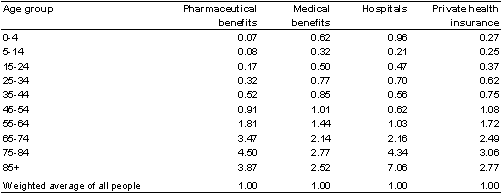
Source: Treasury estimates based on data from the Department of Health and Ageing, Department of Veterans’ Affairs, Medicare Australia, Australian Institute of Health and Welfare, and Private Health Insurance Administration Council.
Chart C1: Index of the age profile of health spending per person
(weighted average of all people = 1)
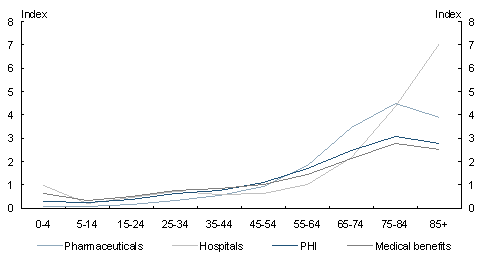
Pharmaceutical benefits
The pharmaceutical benefits model covers spending under the Pharmaceutical Benefits Scheme (including the Highly Specialised Drug Program) and the Repatriation Pharmaceutical Benefits Scheme.
Since IGR1, new data has become available from Medicare Australia to determine a more accurate age-gender profile of spending per person. The annual cost across age and gender cohorts varies from around $20 per person to around $1,500 per person, with spending on women greater than on men.
The nominal total cost of pharmaceutical benefits each year is compiled and the analysis starts from 1983-84. This start date includes 20 years of readily available data with some policy changes.
The total nominal spending series is adjusted for changes in CPI and population size and structure (ageing) to derive a real per person age-adjusted spending series for pharmaceutical benefits. The non-demographic growth rate then is calculated by fitting trends to this series.
Real age-adjusted pharmaceutical spending per person is increasing (Chart C2). An exponential trend more closely fits the historical data than a linear trend and implies an annual non-demographic growth rate of 6.3 per cent. This estimated growth rate is significantly higher than growth observed in other components of health spending.
Chart C2: Real age adjusted pharmaceutical spending per person
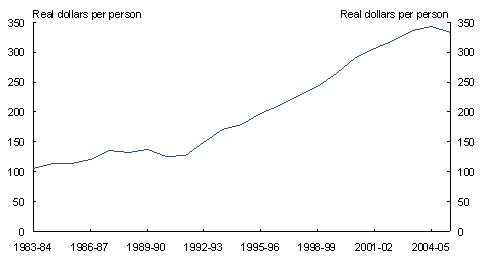
While the exponential trend fits the historical data marginally better than a linear trend, both trends have good explanatory power. However, the implications of applying the different trends to the projections are significant (Chart C3).
While historical trends suggest pharmaceutical benefits will continue to grow strongly and become an increasing share of Australian Government health spending over the next 40years, over the longer term, constant exponential growth of this magnitude is unlikely to be sustained. This report assumes that over the longer term, growth in pharmaceutical benefits will reflect overall growth in health spending, resulting in a more stable proportion of the health budget being devoted to pharmaceuticals. This is because pharmaceuticals are not consumed in isolation from other health care services, but form part of a broader health care plan for individuals, and government health policy reflects this.
This is modelled by a gradual decline in the non-demographic growth rate over the projection period following an arbitrary logistic curve from 6.3 per cent per year to 3.4percent per year, which is the non-demographic growth rate of total Australian Government health spending over the last 20 years.
Chart C3: Projected real pharmaceutical spending per person
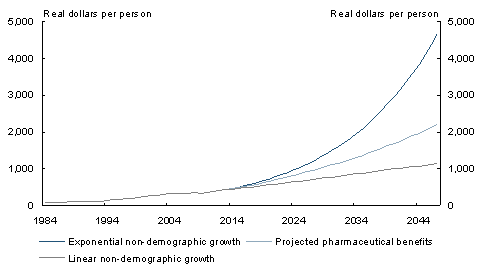
Medical benefits
The medical benefits model includes spending under the Medicare Benefits Schedule and equivalent age- and gender-specific spending rates for veterans.
Greater availability of data on medical benefits allows for the calculation of different non-demographic growth for men and women in a given age range. To calculate accurate real per person spending rates, the historical population series used removes veterans, who receive medical services under separate arrangements to the Medicare Benefits Schedule. Due to limitations in the availability of veteran population data, the historical series used covers 1988-89 to 2005-06 (Chart C4).
Fitting trends to these spending series indicates that non-demographic growth in medical benefits historically has followed a largely linear trend. Forward projections for medical benefits are based on these observed linear trends in non-demographic growth. Calculated growth is very low for age groups below 65 and highest for men aged 75-84 and over 85.
Chart C4: Real medical benefits spending per person
selected age groups
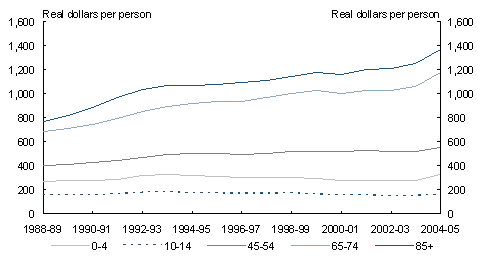
Adoption of linear non-demographic growth for medical benefits is a change in methodology from IGR1, which calculated annual percentage growth rates based on data for 1984-85 and 2000-01.
Hospitals
The hospitals model includes spending on the Australian Health Care Agreements, equivalent age- and gender-specific spending rates for veterans and proximity to death spending.
Greater availability of hospital spending data has enabled the calculation of non-demographic growth for both men and women across a larger age range than in IGR1.
To calculate accurate real per person spending rates, the historical population series excludes veterans, who receive hospital services via White and Gold Card arrangements. Decedent and non-decedent hospital spending also are modelled separately to accurately reflect the level of hospital spending incurred in the last year of life.
Decedent spending is calculated using a proximity to death calculation to attribute a portion of hospital spending to the last year of a person’s life (decedent) and projects spending forward in line with death rates. Non-decedent spending projects the residual hospital spending (total hospital spending less decedent spending) in line with population growth.
As with the Medicare Benefits Schedule data, fitting trends to the hospital spending series indicates non-demographic growth historically has followed a largely linear trend.
Due to limitations in the availability of hospital spending data, the historical data series covers 1995-96 to 2004-05 (Chart C5).
Chart C5: Real hospital spending per person
selected age groups
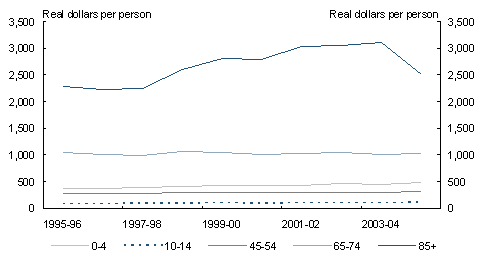
Private health insurance
The private health insurance model incorporates spending on the 30 per cent Private Health Insurance Rebate introduced on 1 January 1999. This rebate is increased to 35percent for people aged 65-69, and to 40percent for people aged 70 and over from 1April2005.
Age- and gender-specific spending rates were calculated by using the age-gender profile of benefits paid out by private health insurers per person. This age profile is used to indicate the impact of ageing on private health insurers’ costs which affects premiums and thus the rebate.
Historical information is compiled on the nominal total cost of the rebate each year, with 2000-01 chosen as the start year for the analysis. This start date excludes the rapid growth in spending in 1999-2000 related to the initial uptake of the rebate and effect of the introduction of Lifetime Health Cover on 1 July 2000.
An exponential trend for non-demographic growth was found to provide the greatest explanatory power, and was fitted to the real per person age-adjusted spending series, resulting in a growth rate of 4.4 per cent per year. As the historical spending figures do not fully reflect the recent increase in the rebate for older Australians, this growth rate is likely to be conservative.
Other health spending
The other health spending model includes all other Australian Government health spending but does not include administration expenses. Major components of other health include:
- health workforce programmes, including payments to general practitioners for infrastructure, training and support, and the Practice Incentive Program;
- population health and safety programmes, including funding of essential vaccines;
- health and medical research; and
- spending on veterans’ health care.
Spending on veterans’ health care included in the other health model represents the additional spending on this group compared to Australian Government spending on other Australians. Projected spending is based on a linear projection of real spending perperson derived from a historical series of spending for 1993-94 to 2004-05. These perperson spending rates then were combined with population projections from the Department of Veterans’ Affairs and CPI assumptions.
The remaining spending in the other health model is projected as a linear trend on historical spending since 1994 expressed as a proportion of GDP. This approach is adopted as other health spending is not directly driven by demographic factors but has grown steadily in the past.
|
Health spending data sources |
|
Pharmaceutical benefits |
|
Age-cost profiles Average of age-cost profiles for 2002-03, 2003-04, 2004-05 and 2005-06. Data includes all Pharmaceutical Benefits Scheme and Repatriation Pharmaceutical Benefits Scheme spending administered by Medicare Australia sourced from Medicare Australia. An age-cost profile was imputed for some special arrangements pharmaceutical spending which is not administered by Medicare Australia and for which an age-cost profile is unavailable. Historical programme spending Pharmaceutical Benefits Scheme data from Table 16(b) Pharmaceutical Benefits Scheme, Government Cost — History, Expenditure and Prescriptions Twelve Months to 30 June 2006, Department of Health and Ageing website. Repatriation Pharmaceutical Benefits Scheme data from Department of Veterans’ Affairs annual reports and Medicare Australia website. |
|
Medical benefits |
|
Historical programme spending by age and gender Data sourced from Table D2 — Benefits Paid, Medicare Statistics, Department of Health and Ageing website. Veterans’ population data supplied by the Department of Veterans’ Affairs. |
|
Hospitals |
|
Age-cost profiles Public hospital spending ratios supplied by Australian Institute of Health and Welfare. Cost of death ratios provided by the Productivity Commission. Veterans’ population data suppli Historical programme spending Public hospital spending data from Department of Health and Ageing and Australian Institute of Health and Welfare. |
|
Private health insurance |
|
Age-cost profiles Average of Private Health Insurance Advisory Council hospital and ancillary benefits paid data for 2002-03, 2003-04, 2004-05 and 2005-06. Historical programme spending Private Health Insurance Rebate spending data from Department of Health and Ageing and Australian Taxation Office annual reports. |
|
Other health |
|
Historical programme spending Computed from annual report data compiled by the Department of Health and Ageing, covering spending by that department, the Department of Veterans’ Affairs and the Australian Taxation Office. Veterans population data supplied by the Department of Veterans’ Affairs. |
Aged care
Projections are based on current spending per person receiving aged care services (indexed for growth in costs) and the projected number of older people. The projection combines base participation rates by age and gender for the main aged care programmes with the projected population by age and gender. Together with assumed growth in the average (government) cost per participant, this provides a base projection. The projection method is broadly similar to the one used in IGR1 and adapts and extends the aged care model used in the 2005 Productivity Commission report.
Decomposition of the projections confirms that the dominant factor in aged care spending is the number of people aged over 80, as the proportional use of formal aged care services increases rapidly for both men and women beyond this age. As noted elsewhere, the proportion of 80-year-olds in the Australian population is expected to almost treble over the projection period. Thus ageing will exert substantial pressure on aged care spending.
The projections directly allow for factors influencing the participation rate by programme (such as disability rates, the trend to increased community care and availability of carers). The model also reduces cost to government by increasing private contributions in line with the growing real income and wealth of participants over the projection period.
Changes in the unit cost of care
Labour costs, which represent around three-quarters of total residential costs and a slightly higher proportion of the cost of community care services, dominate the cost of aged care (Hogan 2004). Upwards pressures on wages in this sector reflect a shortage of nurses in general and aged care workers in particular. Real unit costs have grown and will continue to grow in aged care, reflecting quality improvements, increasing frailty and wage pressures, counterbalanced by improvements in productivity in the sector. In these projections, real unit costs are assumed to grow at 1.75 per cent per annum. IGR1 used this approach and so did the Productivity Commission.
Disability rates
The proportion of the population likely to seek long-term aged care is correlated with the numbers classified as having severe or profound levels of disability. Thus reductions in rates of severe disability among older age groups, and the greater use of technology to allow people to live independently, could partially offset the greater demand for aged care coming from increased numbers of older people.
The Australian Bureau of Statistics surveys of disability suggest a relatively stable prevalence rate of severe disability in the older population. Based on the international evidence, Hogan (2004) concluded age-specific rates of severe and profound disability are likely to decline moderately in the future. In line with Hogan’s view, the Productivity Commission also assumed a 0.25 per cent annual decrease in disability, reflected in participation rates by age. Nonetheless, in line with the approach taken in IGR1, and in the absence of substantial evidence for Australia, the base projections presented here do not assume any change in severe disability. This assumption is an important one and the impact of falling disability at the Hogan rate would reduce the base projections by around 0.2 per cent of GDP.
Change in the care mix and role of informal care
Most older people wish to remain and be cared for in the community for as long as possible. Reflecting current trends and policy, these projections incorporate some change in care mix away from low-level residential care to community care over the medium term.
Planning ratios
Government planning ratios specify the number of aged care places per 1,000 people aged 70 and over, and also the composition of these places. In 2004, the planning ratio was raised from 100 to 108. The February 2007 Government response to the Hogan Report raises this to 113 by 2011. As the projections primarily reflect demand for aged care, they have not been constrained to meet these planning ratios.
Impact of a wealthier aged population
Treasury’s RIMGROUP model that underlies the projections of age pensions projects the increasing income and wealth of successive cohorts of retirees. This modelling maps the maturing of the Superannuation Guarantee arrangements and other Government policies, such as the Simpler and Streamlined Superannuation package and the co-contribution. The results extend the established trend of higher private incomes and wealth interacting with means tests to constrain future spending on age pensions. Similarly, means tests apply in aged care, and the projections model the effect on Australian Government costs as the increasing income and wealth of participants generates higher private contributions.
Chart C6 shows that superannuation assets are projected to rise from 100 per cent of GDP to around 180 per cent by 2046-47. Importantly, superannuation assets are not projected to decline as the baby boomers retire and withdraw their assets but their growth relative to GDP is projected to slow. The impact of higher wealth is shown in the projected decline of full rate pensioners and in the projected rise in part-rate pensioners and non-pensioners in the chart.
Chart C6: Superannuation assets and Age Pension coverage projections
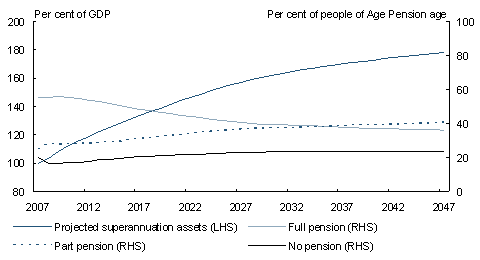
Income support payments
Coverage trend models
Coverage trend models were used when spending was strongly related to participation rates for a payment and the unit cost growth was linked to a price index. These models were used to project spending in Disability Support Pensions, Parenting Payment Single, Parenting Payment Partnered, Newstart Allowance, Mature Age Allowance, Youth Allowance (Student and other), Austudy, Wife Pension, Carers Allowance, Family Tax Benefit, Child Care Benefit and Maternity Payment.
The approach takes historical data on coverage or participation (in a payment or service) and extracts the trend to give a coverage or participation projection for the future, usually by age and gender. This projection is used with the population (or unemployment) projections and a standard unit cost to project the future level of expenses. The standard unit cost is usually independent of age or gender and assumed to grow in the future in line with either wages or CPI growth (or a mixture). The projection of coverage often involves non-linear techniques such as logistic functions.
The modelling for the Disability Support Pension illustrates the process. Disability Support Pension uptake has grown strongly from 220,000 recipients in 1
983 to 707,000 recipients in June 2005 (see Chart 3.6). The upward trend in Disability Support Pension recipients has started to flatten out since IGR1, except for women aged 60-64 (Charts C7 and C8).
Chart C7: Historical Disability Support Pension coverage rates
males by age
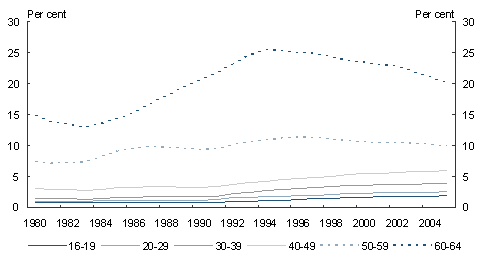
Chart C8: Historical Disability Support Pension coverage rates
females by age
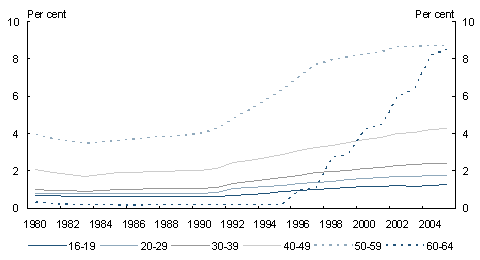
The coverage rates were projected based on historical trends for seven age groups, with growth being gradually slowed. The number of Disability Support Pension customers in the future is expected to decrease with potential new customers being required to go onto Newstart Allowance if they are assessed as able to work 15 hours or more perweek at award wages. To project the number of recipients for a given year, these rates were multiplied by the population in each age group. The numbers then were adjusted to allow for a decrease resulting from the Welfare to Work initiatives. An average rate of payment was calculated for Disability Support Pension and indexed by wages (MTAWE) for future years. Projected nominal spending was derived by multiplying the projected recipient numbers and the indexed rate per recipient, and benchmarked to the forward estimates. Finally, the GDP projection was used to calculate the projections as a proportion of GDP.
|
Coverage rates |
Future trends |
Unit cost growth |
|
|
Disability Support Pension |
Derived for seven age groups for men and women |
Logistic curves used to taper growth and numbers adjusted for Welfare to Work. |
MTAWE |
|
Parenting Payment Single |
Derived for six age groups for men and women |
Logistic curves used to taper growth and numbers adjusted for Welfare to Work. |
MTAWE |
|
Newstart Allowance |
Derived for six age groups |
Initial coverage based on recent average then adjusted for Welfare to Work. |
CPI |
|
Parenting Payment Partnered |
Derived for six age groups for men and women |
Initial coverage based on recent average then adjusted for Welfare to Work. |
CPI |
|
Carer Payment and Wife Pension |
Derived for seven age groups for men and women |
Logistic curves used. |
MTAWE |
|
Youth Allowance Student |
Derived for three age groups for men and women |
Coverage based on recent average. |
CPI |
|
Family Tax Benefit |
Average per child for FTBA and per family for FTBB |
Coverage based on recent average then adjusted for budget changes. |
MTAWE and CPI |
|
Child Care Benefit |
Average per child |
Coverage based on female labour force participation. |
CPI |
|
Maternity Payment |
Average per child |
Projected number of babies. |
CPI |
Comprehensive policy models
RIMGROUP is a comprehensive cohort projection model of the Australian population, which starts with population and labour force models, tracks the accumulation of superannuation, estimates non-superannuation savings, and calculates pension payments and the generation of other retirement incomes (after all taxes). The model is consistent with current policy and includes known future policy changes such as increasing the Age Pension eligibility age for women, increasing the superannuation preservation age, and continuing evolution of the superannuation system, including the major changes taking place from 1 July 2007.
Numbers of pension recipients and the level of payments are calculated by the model, based on population, labour force participation and asset and income projections. Thresholds and withdrawal levels associated with income and assets tests are modelled in detail.
RIMGROUP’s ability to estimate improvements in retirement income and assets make it superior to trend projections of age pensions or those using a coverage rate approach. It projects in detail the higher retirement incomes of Australian retirees as the superannuation system matures and reflects this as a restraining influence on Australian Government spending on age pensions over time.
The usual approach to testing such models is to see how they track history and to check their predictive ability. Testing on RIMGROUP has shown good results in respect of both tracking history and predicting likely outcomes from policy changes. The current projections have been benchmarked to the forward estimates.
Education
Education projections are done by projecting the total number of students and separately multiplying this by the projected average cost per student for each sector. Then the total costs for the sectors are aggregated to calculate total education spending.
For university education, logistic functions were used to project participation rates for male and female students separately by single year of age for those aged 17-29 (the main group from which university students are drawn), by 10-year age groups for people aged 30-59, and for a single group aged 60 and over. Only students in Australian Government supported places are included in the projections.
For vocational training and education, separate participation rates were projected again for men and women, and use logistic functions for each year of age from 14-29, by 5-yearage groups for those aged 30-64 and for a single group aged 65 and over.
For schools, average participation rates for boys and girls for each year of age from 1994 to 2005 were used in the projections. Additionally, the proportion of students attending government and non-government schools was projected. This allowed separate calculation of student numbers attending State government and non-government schools to 2046-47.
The projected total numbers of students in each education sector for a given year were obtained by multiplying projected participation rates by the projected total population in each age group or year of age.
Total spending to 2009-10 reflects forward estimates. From 2010-11, average Australian Government contributions per student in each sector (and for schools by government and non-government schools separately) were calculated. Total Australian Government spending for 2009-10 by sector is divided by the projected total number of participants in each sector; this average cost then is indexed for projected increases in inflation and wages growth. For other education spending, the Aust
ralian Government contribution was divided by the total number of all students, as the spending cannot be allocated to any one sector. This cost per student then was similarly indexed.
The indexed Australian Government contributions per student were multiplied by the projected student populations to obtain nominal spending for each sector, and added to obtain projected nominal total Australian Government spending on education. Finally, the GDP projection was used to calculate the projections as a proportion of GDP.
In effect, this methodology projects future Australian Government education funding based on the current Australian Government spending combined with projections based on demographic change and economy-wide cost growth, rather than modelling it as a continuation of current funding arrangements.
Defence
Defence is part of other spending, which is assumed to retain a broadly constant share of GDP as a whole. Defence spending is difficult to project, as it depends largely on unquantifiable variables such as the strategic environment. However, a review of alternative candidates for the projection methodology can help test whether the assumption is reasonable.
A simple method is to extend the long-run (30-year) historical trend real growth rate (around 2.3 per cent per year) beyond the forward estimates. Alternatively, the Government’s commitment to 3 per cent real growth in base funding could be assumed to extend beyond its current expiry in 2015-16.1
Two further methods focus on particular factors that influence defence spending. ‘Maintain force structure’ identifies cost trends in broad components of defence spending, such as military equipment and personnel. This follows the approach taken in the Australian Strategic Policy Institute’s 2004 report on long-term defence costs.2
‘Maintain relative capability’ uses projections of international economic growth to assess how Australian defence spending might evolve to follow trends in other countries. In this method, each country is assumed to maintain its military spending as a constant share of its GDP, which may overestimate the outcome due to an apparent historical trend for military spending to decline relative to GDP as countries develop. However, as world GDP grows more strongly than Australia’s, Australia would need to devote an increasing share of GDP to defence to maintain spending parity.
None of these models address the full range of influences on the defence budget, and as such, each alone does not provide a compelling projection methodology. Accordingly for the purposes of IGR2, defence has been included as part of other spending, and assumed to grow broadly in line with the economy over the next 40 years.
1 These projections apply from the end of the forward estimates (2009-10), consistent with the report. In the 3 per cent real growth scenario, the projections up to 2015-16 are based on existing funding commitments. The other scenarios initially show higher projections because they derive from the level of defence spending in 2009-10, including supplementation for certain short-term measures such as operational deployments.
2 Thomson, M.A., 2004, Trillion Dollars and Counting: Paying for Defence to 2050, Australian Strategic Policy Institute, March.